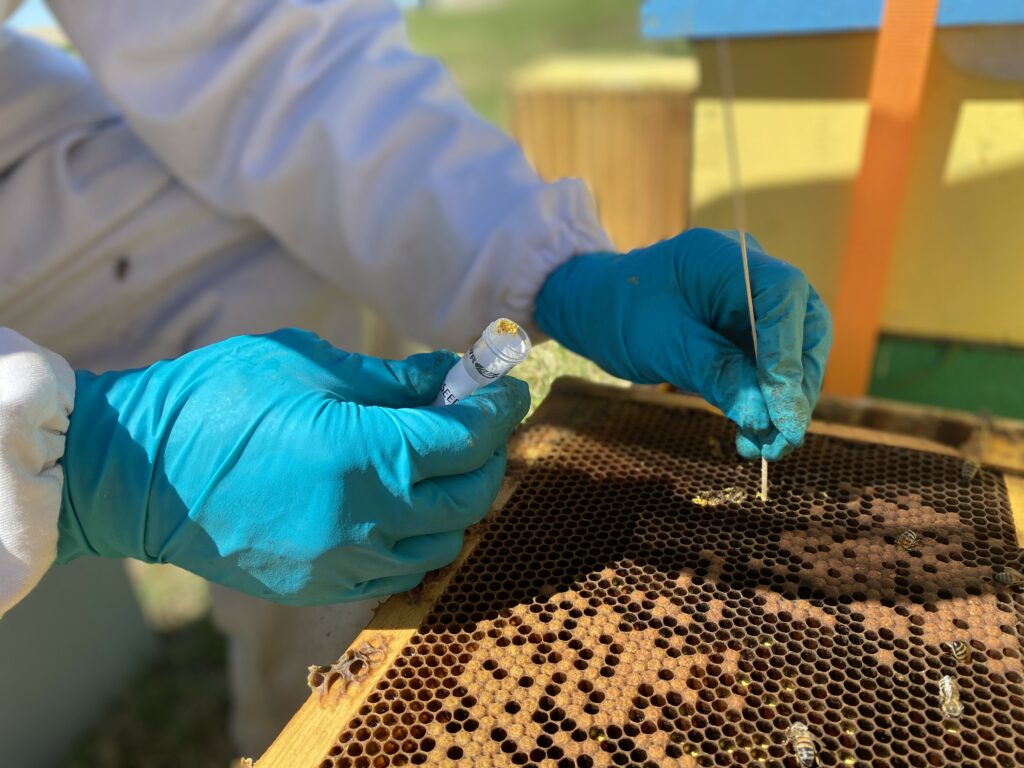Media Release from April 17, 2024
It’s not a single pesticide or virus stressing honey bees, and affecting their health, but exposure to a complex web of multiple interacting stressors encountered while at work pollinating crops, found new research out of York University.
Scientists have been unable to explain increasing colony mortality, even after decades of research examining the role of specific pesticides, parasitic mites, viruses or genetics. This led the research team to wonder if previous studies were missing something by focussing on one stressor at a time.

“Our study is the first to apply systems level or network analyses to honey bee stressors at a massive scale. I think this represents a paradigm shift in the field because we have been so focussed on finding the one big thing, the smoking gun,” says corresponding author of the new paper York Faculty of Science Professor Amro Zayed, York Research Chair in Genomics. “But we are finding that bees are exposed to a very complicated network of stressors that change quickly over time and space. It's a level of complexity that we haven't thought about before. To me, that's the big surprise of this study.”
The paper, Honey bee stressor networks are complex and dependent on crop and region, published today in Current Biology, takes a much broader look at the interplay of stressors and their effects. The study team also included researchers from the University of British Columbia, Agriculture and Agri-Food Canada, the University of Victoria, the University of Lethbridge, the University of Manitoba, l'Université Laval, the University of Guelph, and the Ontario Beekeepers' Association.
Not all stressors are the same, however. Some stressors are more influential than others – what researchers call the social media influencers of the bee world – having an outsized impact on the architecture of a highly complex network and their co-stressors. They also found that most of these influencer stressors are viruses and pesticides that regularly show up in combination with specific other stressors, compounding the negative effects through their interactions.

“Understanding which stressors co-occur and are likely to interact is profoundly important to unravelling how they are impacting the health and mortality of honey bee colonies,” says lead author, York Postdoctoral Fellow Sarah French of the Faculty of Science.
“There have been a lot of studies about major pesticides, but in this research, we also saw a lot of minor pesticides that we don’t usually think about or study. We also found a lot of viruses that beekeepers don’t typically test for or manage. Seeing the influencer stressors interact with all these other stressors, whether it be mites, other pesticides or viruses, was not only interesting, but surprising.”
French says the way influencer stressors co-occur with other stressors is similar to the way humans experience co-morbidities, such as when someone is diagnosed with heart disease. They are more likely to also have diabetes or high blood pressure or both, and each one impacts the other. “That’s similar to the way we examine bee colonies. We look at everything that's going on in the colony and then compare or amalgamate all the colonies together to look at the broader patterns of what is happening and how everything is related. Two or multiple stressors can really synergize off each other leading to a much greater effect on bee health.”
From Québec to British Columbia, honey bee colonies were given the job of pollinating some of Canada’s most valuable crops – apples, canola oil and seed, highbush and lowbush blueberry, soybean, cranberry and corn. The study covered multiple time scales, providing numerous snapshots, rather than the usual single snapshot in time. The research team found that honey bees were exposed to an average of 23 stressors at once that combined to create 307 interactions.

Honey bees are a billion dollar industry. In 2021, honey bees contributed some $7 billion in economic value by pollinating orchards, vegetables, berries and oil seeds like canola, and produced 75 to 90 million pounds of honey. Figuring which stressors would provide the most benefit if managed would go a long way toward developing the right tools to tackle them, something beekeepers are often lacking.
The research is part of the BEECSI: ‘OMIC tools for assessing bee health project funded to the tune of $10 million by Genome Canada in 2018 to use genomic tools to develop a new health assessment and diagnosis platform powered by stressor-specific markers.
More research is needed to unravel how the stressors are interacting and impacting honey bee mortality and colony health going forward, says French. “It's really teasing apart which of these compounds might have that relationship and how can we build off this to study those specific relationships.”
It can’t come soon enough, honey bees are currently facing poor health, colony loss, parasites, pathogens and heightened stressors worldwide. Some beekeepers in this country and the United States face a loss over winter of up to 60 per cent of their colonies.
“Our study suggests some combinations are occurring very frequently,” adds Zayed, “and that is relevant because we see them again and again, but we don't know how these combinations affect bee health. It helps to prioritize which experiments we can now take back to the lab and establish how these interactions affect bees.”
